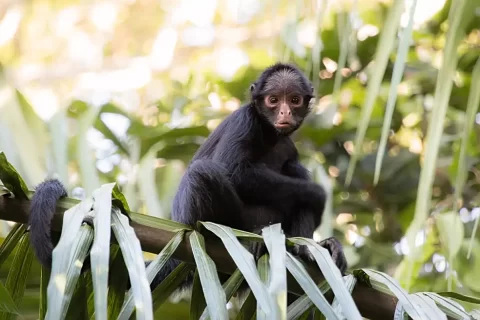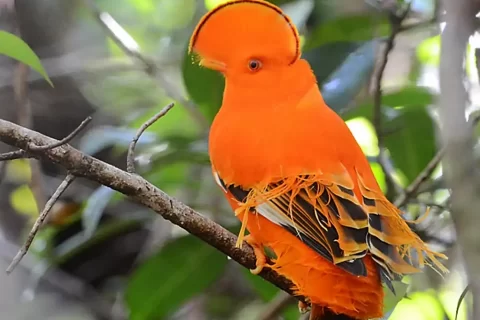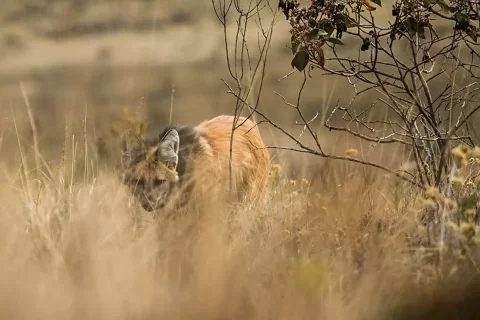Best time of year:
April – December
Duration:
16 days
Difficulty:
Easy. Mostly birding along roads and wide trails. Temperatures comfortable in the highlands (colder May-Sept.), generally hot and humid in the lowlands.
Accommodations:
At Intervales and Legado das Aguas we stay in simple but comfortable accommodations inside the reserves.
Starts in and Ends in:
São Paulo
Tour Overview
The Atlantic Rainforest is one of the most threatened environments in the world. Only seven per cent remains of the original one million square kilometres that the biome once covered across eastern Brazil from its northernmost reaches in North-east Brazil south down the eastern coast to Rio Grande do Sul, and inland to Argentina and Paraguay. Two of South America’s largest cities – São Paulo and Rio de Janeiro – are found within the biome, and the bulk of Brazil’s population and industry occupies an area that was once covered with Atlantic Forest. Approximately 900 bird species occur in the Atlantic Forest, roughly 240 of which are either endemic or nearly endemic to the ecosystem. Our tour covers sites across the states of São Paulo and Rio de Janeiro, including the three of the principal remaining blocks of forest in South-east Brazil. We cover the lower and upper reaches of the section of the Serra do Mar known as the Serra de Paranapiacaba, with three nights at the Legado das Aguas Reserve at 300 metres elevation, home to a great selection of lowland and mid-montane forest birds, followed by three nights at Intervales State Park, certainly the top birding site in all of South-east Brazil. We bird montane forests and high elevations grasslands along the Serra da Mantiqueira mountain chain where we split four nights between the town of Campos do Jordão and Itatiaia National Park. We also explore the lowland coastal plain at the foot of the Serra do Mar at Ubatuba, staying in the coastal resort towns of Ubatuba and Paraty.
Birding is mostly along quiet forested roads or wide trails, and even though we bird in a fair amount of hilly terrain, there are no particularly difficult or overly steep and muddy trails. Several sites have excellent fruit feeder setups that attract colourful tanagers and toucans, and we shall also visit a private home in Ubatuba that has (in our opinions) the best hummingbird feeders in all of Brazil. At Intervales local guides feed a couple of crake species, and also shy forest species such as Solitary Tinamou and Spot-winged Wood-Quail.
Tour Itinerary
Day 1: Arrival in São Paulo. Espinheiro Negro en route to Legado das Aguas.
Most international flights arrive in São Paulo in the morning. Upon arrival, your guide and drive will meet you at the airport. We drive two hours to the Sitio Espinheiro Negro, a small private reserve situated in mid-montane Atlantic rainforest. The excellent hummingbird and fruit feeders here are a lovely introduction to the colourful endemics of the Atlantic Forest, and we’re likely to see our first Red-necked and Green-headed Tanagers, Brassy-breasted Tanager, Violet-capped Woodnymph and Festive Coquette. A short walk on the well-maintained trails might yield our first encounter with Surucua Trogon or Red-breasted Toucan. After a delicious lunch at Espinheiro Negro, we drive another 40 kilometres down into the Legado das Aguas reserve, birding along the way.
Night at Legado das Aguas.
Day 2 & 3: Legado das Aguas.
The Legado das Aguas reserve is the largest privately-owned forest reserve in the Atlantic Forest, covering 31,000 hectares (more than 75,000 acres). The reserve is owned by the Votorantim materials conglomerate, and it was originally established to protect the Juquiá river watershed, where the company built a series of hydroelectric dams several decades ago. We stay three nights in the reserve in fairly simple lodgings overlooking a lake surrounded by lush lowland and mid-montane Atlantic rainforest. There are many kilometres of well-maintained gravel roads through the reserve, in addition to a network of well-constructed trails designed for maximum accessibility. The birding here is phenomenal and it makes for a great first stop in our Crown Jewels tour. Key birds include a long list of threatened species endemic to the Atlantic Forest such as Black-headed Berryeater, Blue-bellied Parrot, Buff-throated Purpletuft, Russet-winged Spadebill, White-necked Hawk, Salvadori’s Antwren, Cinnamon-vented Piha, Oustalet’s Tyrannulet and São Paulo Tyrannulet. We should also see more widespread Atlantic Forest birds including Crescent-chested Puffbird, Rufous-capped Motmot, Unicoloured Antwren, Slaty Bristlefront, Black-cheeked Gnateater, White-breasted Tapaculo, Ochre-breasted Foliage-gleaner, Sharp-tailed Streamcreeper, Eye-ringed Tody-Tyrant, Blue Manakin, Red-ruffed Fruitcrow, and more. Fruit feeders at the restaurant typically attract Plain Parakeet, Yellow-fronted Woodpecker, Green-headed, Red-necked, Ruby-crowned, Olive-green and Golden-chevroned Tanagers, along with Green Honeycreeper, Chestnut-bellied Euphonia, and Red-rumped Cacique. The forested roads throughout the reserve have good sightlines for spotting the fabulous Bare-throated Bellbird as it perches in treetops belting out its far-carrying “BONK!” call. Night birding on the reserve can be good for Black-capped Screech-Owl, Tawny-browed Owl and Mottled Owl.
Nights at Legado das Aguas.
Day 4: Legado das Aguas. Travel to Cananeia.
We have one last morning session at Legado das Aguas, then we depart after lunch to drive for about three and half hours down to the town of Cananéia on the coastal plain in the south of São Paulo state. The coastal restinga forests around Cananéia are home to a handful of specialties, including Restinga Tyrannulet, Black-backed Tanager, Azure Jay and Long-billed Wren. In the late afternoon we watch out for small flocks of Red-tailed Amazons as they head to roost sites around the town. This endangered endemic has a small range on the coast of southern São Paulo and Paraná states. As we head to our hotel in town at the end of the day, we may see flocks of Scarlet Ibis flying over the bay.
Night in Cananéia.
Day 5: Cananeia. To Iporanga.
There will be some time in the morning to bird around Cananéia in case we missed any of the target species the previous afternoon. By mid-morning we will depart to drive about three hours to the Alto Ribeira State Park above the small town of Iporanga. In the afternoon we might visit some hummingbird feeders where we’ll have our first chance for the magnificent Frilled Coquette, or we may check out a rushing river for Fasciated Tiger-Heron.
Night in Iporanga.
Day 6: Iporanga and travel to Intervales State Park.
In the morning we bird the montane forests above Iporanga, likely in the company of one of the excellent local guides who have only recently taken up birding. Even with just a few years of experience of ‘proper’ birding, these guides for the most part have grown up in and around the forest, and their efforts in just a decade or less have put the Alto Ribeira region on the birding map. We’ll bird with a guide to look for Mantled Hawk, Such’s Antthrush, Spot-billed Toucanet, Atlantic Royal Flycatcher, Sharpbill, and much more. In past years, guides located and monitored nests of a pair of rare forest raptors, Ornate Hawk-Eagle and Gray-bellied Goshawk. If either of these species are nesting when we visit, they will be top priorities for us. After lunch we depart to drive a couple of hours to Intervales State Park, stopping along the way to look for Araucaria Tit-Spinetail in groves of its preferred monkey puzzle trees. We arrive to Intervales in the late afternoon, perhaps with time to bird around the park headquarters in search of Black-legged Dacnis, Orange-breasted Thornbird and Rufous-capped Antshrike.
Night in Intervales State Park.
Day 7 & 8: Intervales State Park
Intervales is undoubtedly one of the finest sites in south-east Brazil, and perhaps one of South America’s top five birding sites. With two full days in the park, we’ll have time to explore the many forested tracks and trails in rich montane Atlantic rainforest. All visitors to the park must be accompanied by a local park ranger, and these skilled guides know the park and its birds extremely well. Given good luck with the weather, we should do well on Atlantic forest endemics and our long list of targets here includes Black-fronted Piping-Guan,, Spot-winged Wood-Quail, Red-and-white Crake, Pileated Parrot, Least Pygmy-Owl, Rusty-barred Owl, Long-tufted Screech-Owl, Long-trained Nightjar, Dusky-throated Hermit, Purple-crowned Plovercrest, Helmeted Woodpecker, Gray-bellied Spinetail, White-browed Foliage-gleaner, Scalloped Woodcreeper, Black-billed Scythebill, Giant Antshrike, White-bearded Antshrike, Dusky-tailed Antbird, Variegated Antpitta, Spotted Bamboowren, White-breasted Tapaculo, Hooded Berryeater, Cinnamon-vented Piha, Serra do Mar Tyrant-Manakin, Bay-ringed Tyrannulet, Atlantic Royal Flycatcher, Rufous-tailed Attila, Chestnut-backed Tanager, Black-legged Dacnis, Buffy-fronted Seedeater, Temminck’s Seedeater, Gray-throated Warbling-Finch, Half-collared Sparrow and Green-chinned Euphonia. Night birding in and around the park is usually quite good, with Rusty-barred Owl, Long-tufted Screech-Owl, Stygian Owl and Long-trained Nightjar amongst the possibilities.
Nights at Intervales State Park.
Day 9: Travel to Campos do Jordão
Today is a mostly a travel day as we head east across São Paulo up to the highland resort town of Campos do Jordão. We will make a detour in the late morning to stop at some small cattail marshes to look for the Critically Endangered São Paulo Marsh Antwren. We arrive in Campos do Jordão by late afternoon, in time to head out toward the Horto Florestal area where we shall search for the endangered Vinaceous-breasted Amzon.
Night in Campos do Jordão.
Day 10: Campos do Jordão.
Campos do Jordão is the highest elevation city in Brazil, lying at an altitude of just over 1600 metres above sea level in the Serra da Mantiqueira mountain range. Accordingly, our targets here are birds of upper montane forests and high altitude grasslands. Foremost amongst our targets are Swallow-tailed Cotinga, Black-capped Piprites, Rufous-tailed Antthrush, Serra do Mar Tyrannulet and Mouse-coloured Tapaculo in the forests, while in open country we’ll search for Lesser Grass-Finch, Gray-backed Tachuri, Long-tailed Reed-Finch and Cinnamon Tanager. If we arrived too late on Day 9, we’ll have another opportunity to watch the Vinaceous-breasted Amazons in the afternoon as they head to roost sites.
Night in Campos do Jordão.
Day 11: Campos do Jordão to Ubatuba.
This morning we leave the highlands of the Serra da Mantiqueira, crossing the dry Paraíba valley before descending the Serra do Mar mountain chain to the coastal plain. The Paraíba valley is home to significant rice-growing areas, and we’ll make a birding stop in the morning to explore the rice plantations. Depending on the time year and water levels, we may find herons and egrets including perhaps Pinnated Bittern, and waterfowl including White-faced, Black-bellied and Fulvous Whistling-Ducks, along with perhaps Southern Pochard or even South American Comb Duck. We arrive to Ubatuba in the early afternoon and head out to bird the rich lowland forests around this seaside resort town.
Night in Ubatuba.
Day 12: Ubatuba.
We have a full day to bird the lowland forests at the base of the Serra do Mar around Ubatuba. Our plan will be based at this point, at least to some extent, on which lowland species we have yet to find. This might mean a visit to an old cocoa plantation which is fairly reliable for Buff-throated Purpletuft, Tufted Antshrike, São Paulo Tyrannulet, and Orange-eyed Thornbird. We’ll certainly visit a private residence with some of the best hummingbird feeders in all of Brazil where Saw-billed Hermit, Festive Coquette, Brazilian Ruby and White-chinned Sapphire are the stars of the show; the productive forested road in this same area is good for the northern form of Slaty Bristlefront, Scaled Antbird and more.
Night in Ubatuba.
Day 13: Ubatuba to Paraty.
This morning we drive north-east along the coastal highway with its spectacular scenery from Ubatuba to the historic town of Paraty. A morning stop halfway along the way will target a couple of difficult specialties in the form of the Atlantic form of South American Leaftosser (ex- Tawny-throated), Fork-tailed Pygmy-Tyrant, and Buff-bellied Puffbird. After lunch in Paraty, we will spend the afternoon at a site about 45km east of Paraty, birding a track into disturbed forest behind the town of Mambucaba. Here we are looking for the endangered endemic Black-hooded Antwren, a bird with a tiny range in disturbed coastal forests in southern Rio de Janeiro state. Other targets here include the endemic Yellow-eared Woodpecker, in addition to Mantled Hawk, Yellow-throated Woodpecker and Lemon-chested Greenlet.
Night in Paraty.
Day 14: Paraty to Itatiaia National Park.
After an optional early morning walk in the idyllic historic centre of Paraty, we depart to drive up into the mountains once again. By late morning we should be in Volta Redonda, where we will visit a small park to look for the endangered endemic Rio de Janeiro Antbird. In the afternoon we arrive to the famous Itatiaia National Park, Brazil’s oldest national park, driving up into the mountains again to reach our lovely hotel nestled within fabulous montane Atlantic rainforest.
Night in Itatiaia National Park.
Day 15: Itatiaia National Park
Today we bird the Agulhas Negras road, a rough track that winds up through montane Atlantic rainforest, stunted elfin forest, and rocky high altitude grasslands in the border areas between the states of Rio de Janeiro, Minas Gerais and São Paulo. We are likely to bird our way up to the ranger station at 2450 metres, and our targets along the way include Rufous-tailed Antbird, Black-capped Piprites, Serra do Mar Tyrannulet, Buff-throated and Bay-chested Warbling-Finches, and Rufous-backed Antvireo. Higher up we’ll get to a more open area where Green-crowned Plovercrest and the endemic Itatiaia Spinetail occur. The eerie whistles of Black-and-gold Cotingas are usually heard all around up here, and with some careful scanning of the treetops we may find a male perched up in the open. This is a full day trip and we’ll take a packed lunch, returning either in the late afternoon or early evening if we opt to try a site for Giant Snipe on the way back.
Night in Itatiaia National Park.
Day 16: Itatiaia National Park and return to São Paulo.
There will be time for the better part of a morning’s birding in Itatiaia National Park, where by now our targets will be fairly limited. They might well include Southern Antpipit, White-bibbed Antbird, Gilt-edged Tanager and Blue-naped Chlorophonia. Our departure time will depend on whether we have outbound international flights to catch (and the schedules thereof), as the drive from Itatiaia back to São Paulo takes about four hours.
Night in São Paulo, or outbound flights.
End of tour.



















